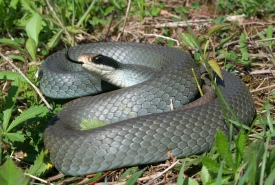12 tweetable facts about Canadian snakes

Blue racer (Photo by Joe Crowley)
In honour of World Reptile Day, here are some interesting tidbits about Canada's native snake species to share with your friends and followers on Twitter:
In Canada, the blue racer snake is found only on Pelee Island. (Tweet this!)
When threatened, the eastern hog-nosed snake plays dead by rolling over and sticking out its tongue. (Tweet this!)
Red-back salamanders are the northern ring-necked snake’s favourite meal. (Tweet this!)
Although it vibrates its tail when threatened, the milksnake is actually a constrictor. (Tweet this!)
The smooth greensnake is excellent at camouflaging itself among shrubs and grasses. (Tweet this!)
Eastern foxsnakes can both climb trees and swim. (Tweet this!)
The common gartersnake is the most commonly distributed reptile in Canada. (Tweet this!)
The harmless eastern hog-nosed snake mimics cobras and rattlesnakes to ward off threats. (Tweet this!)
The gray ratsnake is Canada’s largest species of snake. (Tweet this!)
The queen snake is aquatic and non-venomous, and at maturity can reach lengths of 60-90 centimetres. (Tweet this!)
Despite its fearsome reputation, the massasauga rattlesnake, Ontario’s only venomous snake, is shy and docile and avoids human contact whenever possible. (Tweet this!)
The eastern foxsnake is globally rare, existing only around the Great Lakes basin in southern Ontario, Michigan and Ohio. (Tweet this!)


